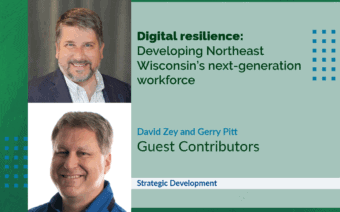
December 16, 2024
Businesses today face the unique challenge of serving up to five generations, each with distinct preferences and technological comfort levels.
Older clients may lack access to or familiarity with digital tools, while younger, tech-savvy customers often expect fast, self-service solutions.
This isn’t simply a technological issue – it’s about understanding and addressing the specific needs of each customer segment.
Instead of relying on a one-size-fits-all approach, the goal is to efficiently steer every customer toward the best experience for their needs, ensuring satisfaction while maintaining competitiveness in an evolving marketplace.
Taxonomy: Understanding through classification, hierarchy
What is taxonomy?
First, let’s clarify what taxonomy is – and no, it’s not taxidermy (don’t worry, no furry animals were harmed in the making of this article).
Taxonomy is the human process of structured classification, used to organize and make sense of the world.
It groups plants, animals, products or even people into meaningful categories.
By establishing hierarchies, taxonomy simplifies complexity, enabling better decision-making and prioritization.
Applying taxonomy to customers might feel uncomfortable, as it involves making judgments about people, but it is essential for businesses to identify patterns, preferences and needs.
This structured understanding allows businesses to create services that truly resonate with their diverse customer base.
Why does this matter?
Taxonomy is critical in business because it answers fundamental questions about customers.
It helps businesses understand who their customers are, how they interact with products and services and what value they bring to the organization.
Likewise, it helps businesses determine the value they offer to different customer groups.
These insights form the foundation for effectively balancing resources and services, ensuring all customer expectations are met without compromising quality.
Segmentation in business: Deciding what matters
How businesses segment customers
Segmentation is key to understanding and meeting diverse customer needs.
Businesses often categorize customers based on product requirements, experience preferences, budget constraints, customer support needs and access to or comfort with technology.
For example, some customers might prefer a high-touch service model with personalized support, while others might favor efficient, self-service options online.
These distinctions are crucial for designing tailored service strategies.
How businesses segment products
Just as customers are segmented, so, too, are products and services.
Businesses often classify their offerings based on features, price points and accessibility.
Some products might be designed as entry-level options, while others target premium customers with advanced features.
Accessibility features, such as physical products versus digital-only solutions, also play a critical role in segmentation, affecting inclusivity for all demographics.
Why segmentation is key
Effective segmentation enables businesses to allocate resources wisely, ensuring no customer group is overlooked.
It allows companies to identify at-risk groups and tailor their service offerings to align with specific needs.
This prevents gaps in service delivery and enhances overall customer satisfaction, fostering loyalty across generations.
Removing friction in the buying experience
The nature of friction
Friction arises when there is a misalignment between customer expectations and business goals.
Customers expect a smooth, satisfying experience that is easy to navigate and reasonably priced.
Businesses have the added concern in managing operational efficiency, cost management and profitability.
These differing priorities often result in tension.
Understanding friction
Friction manifests in various ways depending on the customer demographic.
Older generations may struggle with digital interfaces or prefer in-person interactions, while younger generations often expect fast, self-service digital experiences.
Each group has different expectations, and failing to address these can create frustration on both sides.
Addressing friction
To address friction effectively, businesses need holistic solutions that consider the motivations and pain points of all customer segments.
By designing processes and tools that minimize obstacles, businesses can enhance satisfaction for both customers and the organization.
Examples of friction scenarios in health care
Healthcare providers often face a delicate balancing act between delivering high-quality service and managing costs.
For instance, Medicare’s low reimbursement rates force providers to choose between reducing service quality, limiting services, or absorbing financial losses to maintain their reputation.
Each decision impacts profitability, customer satisfaction and brand credibility.
Similarly, care navigation for self-insured employers highlights generational friction.
Older patients often prefer phone-based or in-person assistance, requiring more resources, while younger patients expect the convenience of online portals or mobile apps.
Striking the right balance between high-touch services and digital tools is essential, as failing to do so can lead to member disengagement and missed opportunities for cost-effective care delivery.
These healthcare examples illustrate a broader, universal challenge: Businesses across industries must balance personalized service with operational efficiency to meet the expectations of diverse customer groups.
Solutions: Bridging the gap between generations
Addressing generational friction requires a hybrid approach that blends strategy, process workflow and routing and innovative technology.
These elements work together to create seamless, inclusive service experiences for all customer groups.
Strategic communication channels
A thoughtful communication strategy is essential for accommodating diverse customer preferences.
Businesses can implement an omnichannel approach, integrating phone, in-person and digital platforms for a seamless experience.
Simplified digital tools with large fonts and intuitive navigation can help older customers feel more comfortable with technology, while partnerships with local organizations can provide in-person or assisted services for those who prefer traditional methods.
By strategically aligning these channels, businesses ensure that no demographic is overlooked.
Optimized process workflows, routing
Streamlined workflows and intelligent routing are key to balancing generational needs.
AI-driven systems can dynamically guide customers to the most suitable service channel.
Older customers may be routed to human agents or voice-based systems for personalized, high-touch interactions.
Tech-savvy customers can be directed to chatbots or self-service portals for quick resolutions. By aligning workflows with customer preferences, businesses can reduce friction, improve efficiency and enhance satisfaction.
Innovative technology for enhanced service
Advanced technologies, such as AI, play a pivotal role in bridging generational gaps and addressing diverse needs.
Voice-enabled AI systems, for instance, not only support older customers who prefer speaking over typing but also address multi-lingual needs in real-time.
These systems can translate and respond in different languages, fostering inclusivity and accessibility across diverse customer bases.
AI-powered tools are beginning to personalize interactions by automating routine tasks while escalating complex inquiries to human agents equipped with detailed AI-generated context.
Adaptive digital interfaces can dynamically adjust based on user behavior, catering to the preferences of younger, tech-savvy customers.
For those who prefer non-digital options, routing to accessible alternatives such as printed materials or voice-command systems ensures that everyone is effectively served.
Transforming existing solutions with AI
Accessibility features such as Interactive Voice Response (IVR) systems, static web portals and basic self-service apps have long helped businesses cater to diverse customer needs.
For example, IVR systems have provided foundational tools for handling customer calls, and web portals have offered simple, user-friendly ways to access information.
Additionally, apps with fixed workflows have helped tech-savvy users navigate basic interactions.
These tools represent the early efforts to create segmented, accessible customer experiences.
What sets AI apart is its ability to modernize and integrate these legacy systems, addressing their limitations.
Traditional technologies often rely on rigid, fragmented frameworks that are costly to maintain and challenging to adapt.
AI doesn’t just replace legacy systems – it builds on them, turning rigid workflows into adaptive processes, ensuring smooth transitions without alienating customers reliant on traditional methods.
AI introduces dynamic, scalable alternatives that transform static systems into flexible, real-time solutions.
For instance, voice-enabled AI enhances or replaces IVR by enabling seamless, multi-lingual and context-aware interactions.
Similarly, AI-powered chatbots extend the functionality of web portals by offering personalized, conversational support.
By streamlining and integrating these tools, AI reduces operational costs and maintenance challenges while enabling continuous improvement.
This allows businesses to deliver more innovative, cost-effective services that resonate with the needs of all generations.
Conclusion: Bridging the gap with innovation, strategy, segmentation
Balancing the needs of diverse generations is not just about deploying new technologies – it starts with understanding the distinct needs of your customer base.
Taxonomy, as a method of classification, helps businesses segment customers effectively, enabling them to align services with generational preferences and operational priorities.
By leveraging this structured understanding, businesses can ensure that both older and younger customers feel seen and supported.
AI enhances this foundational strategy by making segmentation dynamic and adaptive.
Instead of static categorizations, AI enables real-time insights into customer behavior, allowing businesses to respond proactively.
Whether through voice-enabled systems that provide personalized, multi-lingual support for older users or dynamic interfaces tailored to tech-savvy younger generations, AI can help bridge gaps in service expectations while optimizing resources.
By combining segmentation, strategy and AI’s dynamic capabilities, businesses can effectively serve the five generations they cater to.
This approach ensures every customer – regardless of their technological comfort – receives thoughtful, efficient and inclusive service.
By doing so, businesses foster loyalty and competitiveness in an evolving market, proving that innovation and empathy can work hand in hand.
 Old Station 31 Spirits – defined by family, tradition, service
Old Station 31 Spirits – defined by family, tradition, service Making a difference: Jim Casper
Making a difference: Jim Casper








